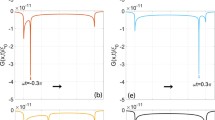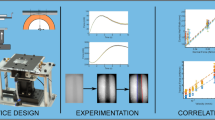Abstract
We present a detailed experimental investigation on viscoelastic rolling contacts. The tests focus on contact area, penetration and viscoelastic dissipation measurements between a nitrile rubber ball rolling on a glass disc. Each of the measured parameters is shown to be dependent on the rolling speed and normal load and has, therefore, been used to assess the main differences between viscoelastic and linear elastic rolling contacts. Experimental outcomes are compared with numerical predictions of the theory proposed by Carbone and Putignano (J Mech Phys Solid, 2013). A good agreement is found between experiments and theoretical predictions, thus demonstrating the validity of the numerical approach. This has important implications for modelling the behaviour of real viscoelastic materials, whose response is characterised by a wide distribution of relaxation times. The presented methodologies and results can be applied directly or are of relevance to a number of engineering components, such as tires and seals.










Similar content being viewed by others
Notes
We observe that, in general, G(x, v) parametrically depends on the thickness h of the layer by means of a geometric correction factor \(\Uptheta (|{\bf x}|/h)\), as shown in [1]. For an infinitely thick layer \((|{\bf x}|/h\rightarrow 0)\), i.e., for a viscoelastic half-space, the correction factor \(\Uptheta (|{\bf x}|/h)\) goes to 1 and G(x, v) is strongly simplified. We also notice that the numerical implementation is also relatively simple if one exploits the Love’s solution for elastic materials [25], as observed in [32].
Here, scatter is defined as σ/μ, i.e., the ratio between the standard deviation σ and the mean measured value μ.
References
Carbone, G., Putignano, C.: A novel methodology to predict sliding/rolling friction in viscoelastic materials: theory and experiments. J. Mech. Phys. Solid. (2013). doi:10.1016/j.jmps.2013.03.005
Bottiglione, F., Carbone, G., Mangialardi, L., Mantriota, G.: Leakage mechanism in flat seals. J. Appl. Phys. 106(10), 104902 (2009)
O’Boy, D.J., Dowling, A.P.: Tyre/road interaction noise—a 3D viscoelastic multilayer model of a tyre belt. J. Sound Vib. 322(4–5), 829–850 (2009)
Craiem, D., Magin, R.L.: Fractional order models of viscoelasticity as an alternative in the analysis of red blood cell (RBC) membrane mechanics. Phys. Biol. 7, 013001 (2010)
Regeva, O., Vandebrilb, S., Zussmana, E., Clasenb, C.: The role of interfacial viscoelasticity in the stabilization of an electrospun jet. Polymer 51(12), 2611–2620 (2010)
Tsujimotoa, T., Uyamaa, H., Kobayashib, S.: Synthesis of high-performance green nanocomposites from renewable natural oils. Polym. Degrad. Stab. 95(8), 1399–1405 (2010)
Hunter, S.C.: The rolling contact of a rigid cylinder with a viscoelastic half space. Trans. ASME Ser. E. J. Appl. Mech. 28, 611–617 (1961)
Harrass, M., Friedrich, K., Almajid, A.A.: Tribological behavior of selected engineering polymers under rolling contact. Tribol. Int. 43, 635–646 (2010)
Grosch, K.A.: The relation between the friction and visco-elastic properties of rubber. Proc. R. Soc. Lond. Ser. A Math. Phys. 274-1356, 21–39 (1963)
Persson, B.N.J.: Rolling friction for hard cylinder and sphere on viscoelastic solid. Eur. Phys. J. E 33, 327–333 (2010)
Panek, C., Kalker, J.J.: Three-dimensional contact of a rigid roller traversing a viscoelastic half space. J. Inst. Math. Appl. 26, 299–313 (1980)
Padovan, J., Paramadilok, O.: Transient and steady state viscoelastic rolling contact. Comput. Struct. 20, 545–553 (1984)
Vollebregt, E.A.H.: User Guide for CONTACT, J.J. Kalker’s Variational Contact Model, Technical Report TR09-03, version 1.18
Nackenhorst, U.: The ALE-formulation of bodies in rolling contact theoretical foundations andfinite element approach. Comput. Method Appl. M. 193, 4299–4322 (2004)
Yoneyama, S., Gotoh, J., Takashi, M.: Experimental analysis of rolling contact stresses in a viscoelastic strip. Exp. Mech. 40(2), 203–210 (2000). doi:10.1007/BF02325047
Carbone, G., Lorenz, B., Persson, B.N.J., Wohlers, A.: Contact mechanics and rubber friction for randomly rough surfaces with anisotropic statistical properties. Eur. Phys. J. E. Soft Matter 29(3), 275–284 (2009)
Persson, B.N.J.: Rubber friction: role of the flash temperature. J. Phys. Condens. Matter 18(32), 7789–7823 (2006)
Goriacheva, G.: Contact problem of rolling of a viscoelastic cylinder on a base of the same material. J. Appl. Math. Mech. 37(5), 925–933 (1973). doi:10.1016/0021-8928(73)90017-8
Christensen, R.M.: Theory of Viscoelasticity. Academic Press, New York (1982)
Padovan, J.: Finite element analysis of steady and transiently moving/rolling nonlinear viscoelastic structure-I theory. Comput. Struct. 27(2), 249–257 (1987)
Padovan, J., Kazempour, A., Tabaddor, F., Brockman, B.: Alternative formulations of rolling contact problems. Finite Elem. Anal. Des. 11, 275–284 (1992)
Nasdala, L., Kaliske, M., Becker, A., Rothert, H.: An efficient viscoelastic formulation for steady-state rolling structures. Comput. Mech. 22, 395–403 (1998)
Le Tallec, P., Rahler, C.: Numerical models of steady rolling for non-linear viscoelastic structures in finite deformations. Int. J. Numer. Meth. Eng. 37, 1159–1186 (1994)
Halaunbrenner, J., Kubisz, A.: ASLE-ASME Lubrication Conference Paper No. 67-Lub-25 , Chicago (1967)
Johnson, K.L.J.: Contact Mechanics. Cambridge University Press, Cambridge (1985)
Krick, B.A., Vail, J.R., Persson, B.N.J., Sawyer, W.G.: Optical in situ micro tribometer for analysis of real contact area for contact mechanics, adhesion, and sliding experiments. Tribol Lett. doi:10.1007/s11249-011-9870-y
Lorenz, B., Persson, B.N.J., Dieluweit, S., Tada, T.: Rubber friction: comparison of theory with experiment. Eur. Phys. J. E. 34, 129 (2011). doi:10.1140/epje/i2011-11129-1
Maugis, D.: Adhesion of spheres: the JKR-DMT transition using a dugdale model. J. Colloid Interf. Sci. 150, 1 (1992)
Felhõs, D., Xul, D., Schlarb, A.K., Váradi, K., Goda, T.: Viscoelastic characterization of an EPDM rubber and finite element simulation of its dry rolling friction. Express Polym. Lett. 2(3), 157–164 (2008)
Olaru, D.N., Stamate, C., Prisacaru, G.: Rolling friction in a micro tribosystem. Tribol. Lett. 35, 205–210 (2009)
Ferry, J.D.: Viscoelastic Properties of Polymers. Wiley, New York (1980)
Putignano, C., Afferrante, L., Carbone, G., Demelio, G.: A new efficient numerical method for contact mechanics of rough surfaces. Int. J. Solid. Struct. 49(2), 338–343 (2012). doi:10.1016/j.ijsolstr.2011.10.009
Putignano, C., Afferrante, L., Carbone, G., Demelio, G.: The influence of the statistical properties of self-affine surfaces in elastic contact: a numerical investigation. J. Mech. Phys. Solid. 60(5), 973–982 (2012)
Carbone, G., Mangialardi, L.: Analysis of adhesive contact of confined layers by using a Green’s function approach. J. Mech. Phys. Solid. 56(2), 684–706 (2008)
Carbone, G., Scaraggi, M., Tartaglino, U.: Adhesive contact of rough surfaces: comparison between numerical calculations and analytical theories. Eur. Phys. J. E. Soft Matter 30(1), 65–74 (2009)
Carbone, G., Mangialardi, L.: Adhesion and friction of an elastic half-space in contact with a slightly wavy rigid surface. J. Mech. Phys. Solids 52(6), 1267–1287 (2004)
Scaraggi, M., Putignano, C., Carbone, G.: Elastic contact of rough surfaces: a simple criterion to make 2D isotropic roughness equivalent to 1D one. Wear 297, 1–2, 5, 811–817 (2013)
Putignano, C., Afferrante, L., Carbone, G., Demelio, G.: A multiscale analysis of elastic contacts and percolation threshold for numerically generated and real rough surfaces. Tribol. Int. 64, 148–154 (2013). doi:10.1016/j.triboint.2013.03.010
de Vicente, J., Stokes, J.R., Spikes, H.A.: Rolling and sliding friction in compliant, lubricated contact. Proc. IMechE, Part J: J. Eng. Tribol. 220, 55–63 (2006)
Williams, M.L., Landel, R.F., Ferry, J.D.: The temperature dependence of relaxation mechanisms in amorphous polymers and other glass-forming liquids. J. Am. Chem. Soc. 77, 3701 (1955)
Michael, K.: Advanced Topics in Characterization of Composites. Trafford Publishing, Bloomington, IN (2004)
Acknowledgments
CP and GC thank the support of the Italian Ministry of Education, University and Research, within the Projects PON01_02238 and PON02_00576_3333604.
Author information
Authors and Affiliations
Corresponding author
Rights and permissions
About this article
Cite this article
Putignano, C., Reddyhoff, T., Carbone, G. et al. Experimental Investigation of Viscoelastic Rolling Contacts: A Comparison with Theory. Tribol Lett 51, 105–113 (2013). https://doi.org/10.1007/s11249-013-0151-9
Received:
Accepted:
Published:
Issue Date:
DOI: https://doi.org/10.1007/s11249-013-0151-9




